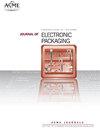The Discussion About the Identification of the Anand Model Parameters and Two Alternative Identification Methods
IF 2.3
4区 工程技术
Q3 ENGINEERING, ELECTRICAL & ELECTRONIC
引用次数: 1
Abstract
The Anand model is a unified viscoplastic model which is widely employed to describe the solder material deformation. The parameters in the Anand model for a certain material are usually identified by using the classical method based on two algebraic equations derived from the original differential equation of the Anand model. However, the second algebraic equation describing the relationship between the stress and inelastic strain is obtained with some terms about the unsteady value of internal variable neglected. But the effects induced by the omission of some unsteady terms on the effectiveness of classical method are not researched comprehensively. Therefore, in this paper, the effects of the omitted terms on the accuracy of the classical method are discussed. The inelastic deformation for the material which the second algebraic equation can not describe due to the omission of unsteady terms is presented. The precondition for obtaining accurate results from the second algebraic equation is given out. Two criteria used to judge the effectiveness of the second algebraic equation are derived. To reduce the error related to the second algebraic equation of the classical method for some materials, two alternative identification methods are proposed. By combining the step of solving differential equation and genetic algorithm, the parameters in the Anand model originally identified by the second algebraic equation are determined in the process of the two proposed methods. The effectiveness of the two alternative methods is presented by identifying the material Anand parameters where the classical method can not be applied.关于阿南德模型参数辨识及两种辨识方法的讨论
Anand模型是一个统一的粘塑性模型,广泛用于描述焊接材料的变形。对于某种材料,Anand模型中的参数通常是通过使用基于从Anand模型的原始微分方程导出的两个代数方程的经典方法来识别的。然而,在忽略了关于内变量非定常值的一些项的情况下,得到了描述应力和非弹性应变之间关系的第二个代数方程。但是,一些非定常项的遗漏对经典方法有效性的影响并没有得到全面的研究。因此,本文讨论了省略项对经典方法精度的影响。给出了由于省略了非定常项,第二代数方程无法描述的材料的非弹性变形。给出了从第二代数方程中获得精确结果的前提条件。导出了判断第二代数方程有效性的两个准则。为了减少某些材料的经典方法的第二代数方程的误差,提出了两种可供选择的识别方法。通过将求解微分方程的步骤与遗传算法相结合,在两种方法的过程中确定了由第二代数方程识别的Anand模型中的参数。在经典方法无法应用的情况下,通过识别材料Anand参数,证明了两种替代方法的有效性。
本文章由计算机程序翻译,如有差异,请以英文原文为准。
求助全文
约1分钟内获得全文
求助全文
来源期刊

Journal of Electronic Packaging
工程技术-工程:电子与电气
CiteScore
4.90
自引率
6.20%
发文量
44
审稿时长
3 months
期刊介绍:
The Journal of Electronic Packaging publishes papers that use experimental and theoretical (analytical and computer-aided) methods, approaches, and techniques to address and solve various mechanical, materials, and reliability problems encountered in the analysis, design, manufacturing, testing, and operation of electronic and photonics components, devices, and systems.
Scope: Microsystems packaging; Systems integration; Flexible electronics; Materials with nano structures and in general small scale systems.
 求助内容:
求助内容: 应助结果提醒方式:
应助结果提醒方式:


